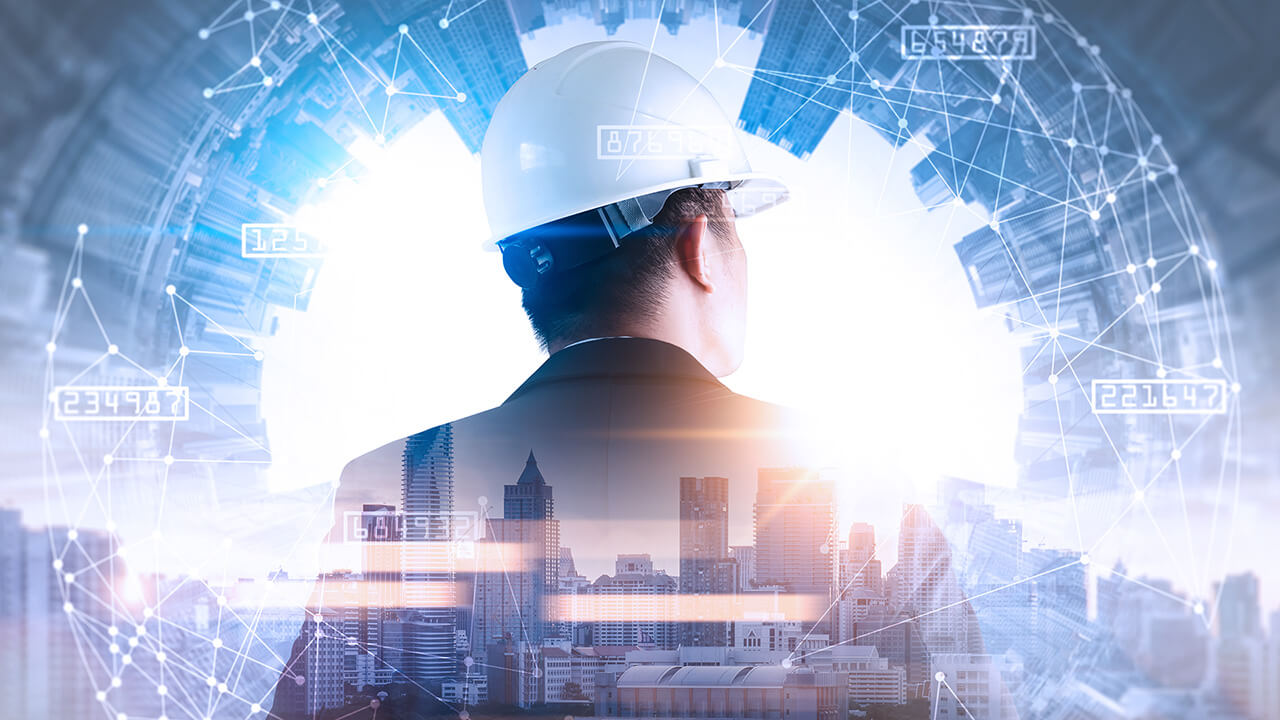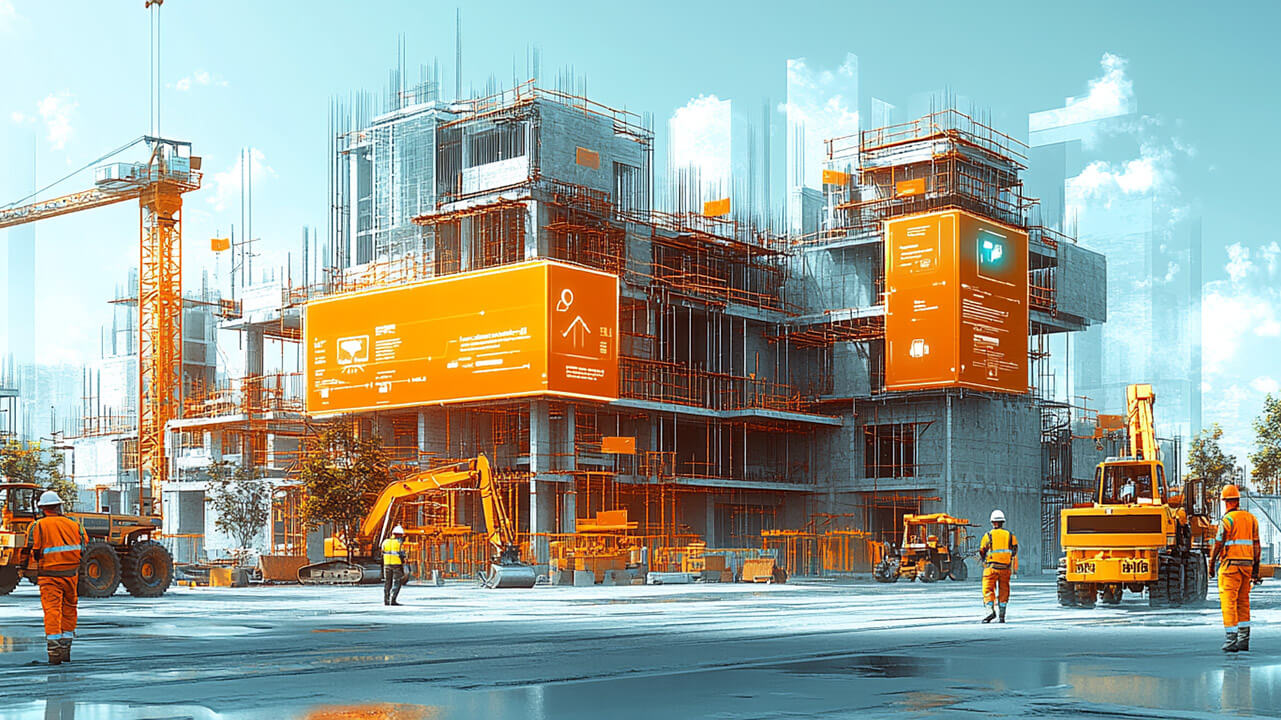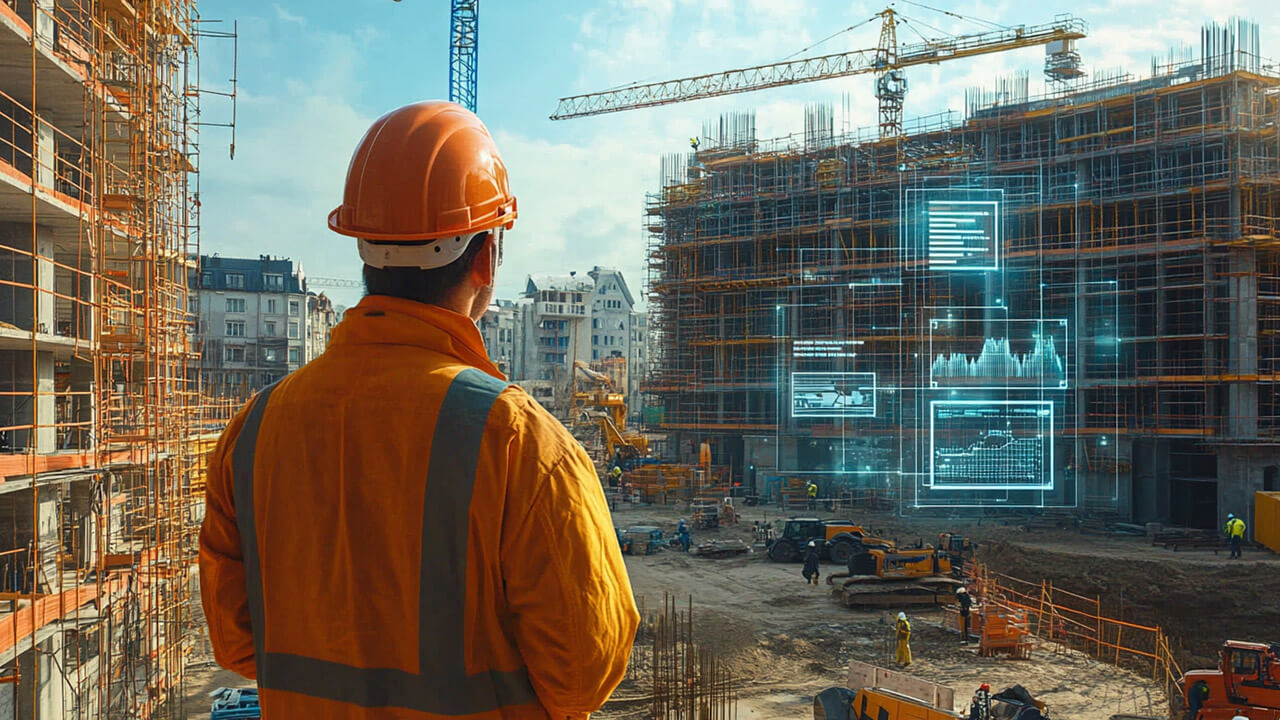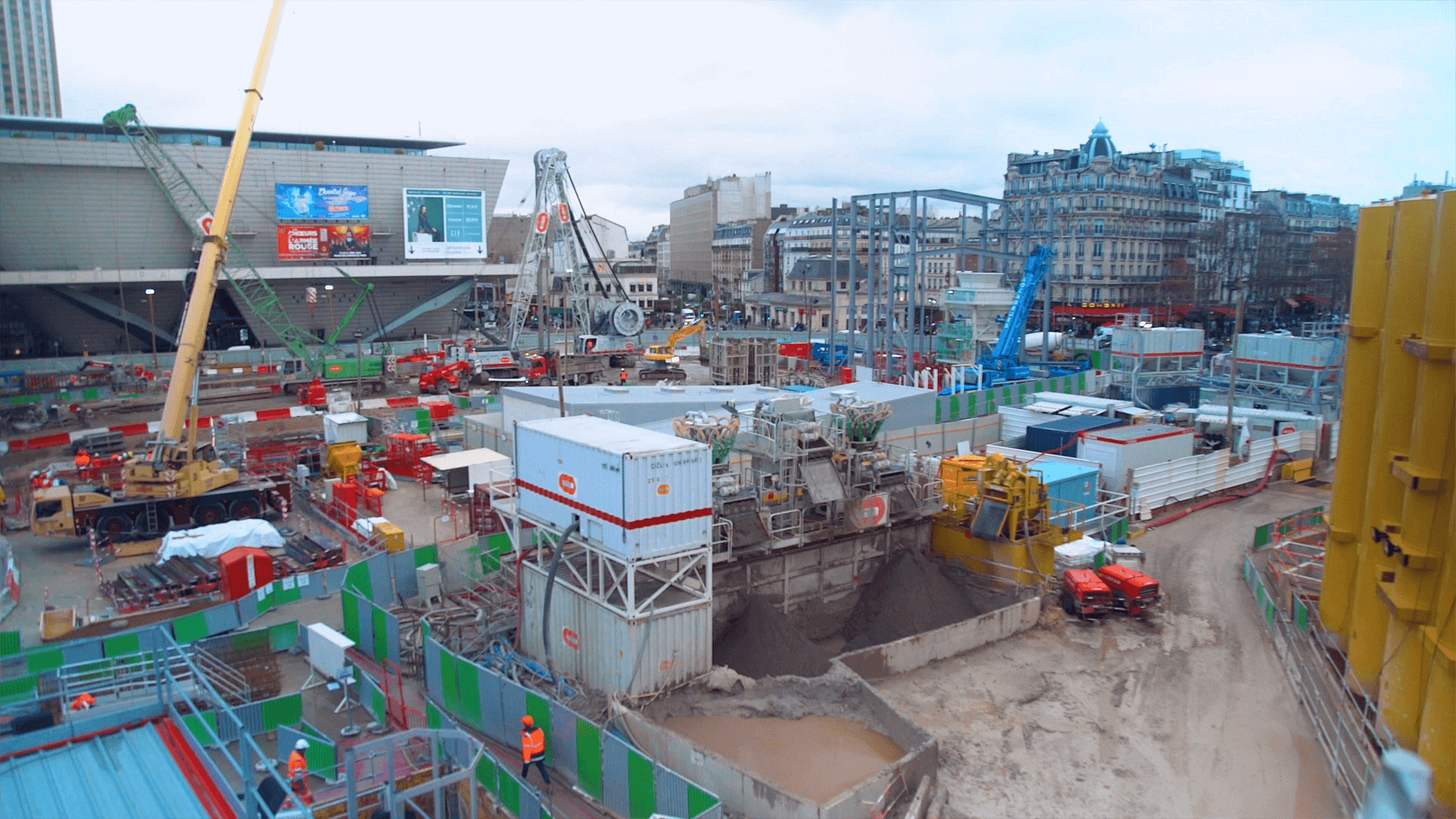The rise of AI in construction management
Featured topics:
Interested to learn more about AI in construction?
Why AI matters in construction
Digital tools are now widespread in the construction industry. From mobile forms to drones and sensors, construction is generating more field data than ever before. However, collecting data is only the first step. The true opportunity is using that data to drive better decisions, reduce risk, and improve efficiency. That’s where AI is making a difference.
Artificial Intelligence (AI) is no longer a futuristic concept. It is already helping teams automate repetitive tasks, identify potential risks early, and extract insights from complex site data.
This article explores how AI in construction works, the value it brings today, the requirements for success, and what the future holds.

What is AI and how does it apply to construction?
In simple terms, AI refers to technologies that enable machines to perform tasks that usually require human intelligence. Here are three types of AI relevant in Construction:
- Large Language Models (LLMs): Understand and generate text. Useful for chatbots, summarising reports, or creating documents.
- Computer vision: Enables machines to analyse images and video. Helpful for monitoring progress, identifying safety risks, or detecting defects.
- Machine learning (ML): Finds patterns in historical data to make predictions — for example, forecasting delays or safety incidents.
Comparison of AI technologies in construction
| Type of AI | Designed For | Pros | Limitations |
|---|---|---|---|
| LLMs | • Content creation & review • Chatbots • Data analysis • Coding |
• Cost-effective • Saving time in creating, reviewing and summarising information |
• Can hallucinate or generate incorrect info |
| Video AI | • Real-time site monitoring • Safety compliance • Access control |
• Real-time • Non-intrusive (visual data only) |
• Expensive (good camera set up) • Not 100% accurate • Privacy concerns |
| AI Predictive Models | • Forecasting safety risks, delays, cost overruns, equipment failures, quality issues | • High accuracy with clean data • Useful for decision-making |
• Needs large reliable datasets • Can become outdated if patterns shift |
Trends in AI adoption
Recent research by the University of Melbourne highlights the fast rise of AI in the workplace:
- In emerging economies, 72% of employees regularly use AI, compared to 49% in advanced economies.
- Over 50% report performance improvements from using AI tools.
- However, 52% admit making mistakes with AI,
- And many have uploaded confidential company data into public AI platforms like ChatGPT.
This highlights an important point: as AI use increases, it needs to be supported by good governance and secure tools.
Key use cases of AI in construction management
#1 Safety compliance and risk prediction
Construction sites are inherently risky environments, and ensuring safety compliance is a top priority. AI offers two powerful tools in this domain: video analytics and predictive risk models.
- Video AI can analyse live CCTV or site footage to spot safety violations as they happen. It can identify issues like workers not wearing personal protective equipment (PPE) or entering areas that are off-limits. This technology works like a continuous site supervisor, sending alerts without needing a person to watch all the time.
- Predictive analytics use historical incident data to flag high-risk activities or locations.
Benefits: improve compliance and reduce incidents.
#2 Quality control and compliance
Maintaining consistent quality across complex builds is a constant challenge. AI can assist by identifying defects early and streamlining compliance documentation.
- Computer vision algorithms can scan photos or videos to detect anomalies like cracks, water damage, or surface defects.
- LLMs (Large Language Models) can automatically generate or summarise inspection reports, reducing paperwork and ensuring documentation is complete and standardised.
Benefits: Early defect detection and faster handover preparation.
#3 Progress tracking and forecasting
AI offers new ways to measure progress and predict future delays:
- Computer vision and drone footage can be analysed to track work completed versus planned milestones.
- AI can also assess site diaries, construction schedules, and daily reports to detect discrepancies and forecast likely schedule slips.
Benefits: Faster progress reporting and real-time visibility on project planning
#4 Predictive maintenance and asset monitoring
Predictive maintenance can prevent unplanned equipment failure that halts progress and inflates costs. AI enables predictive maintenance by analysing sensor data from machinery to forecast failures before they happen.
- Systems monitor temperature, vibration, or usage patterns in real time. When AI identifies abnormal readings, it can automatically flag the asset for inspection or servicing.
- This reduces downtime and extends the lifespan of expensive equipment.
Benefits
- Optimised resources and maintenance schedules
- Fewer unplanned breakdowns
- Increased equipment ROI
In summary:
From safety and quality to scheduling and equipment, AI is already proving its value across the construction lifecycle. What sets leading platforms apart is their ability to integrate these capabilities seamlessly.

What’s needed to make AI work on site?
AI offers enormous potential, but its success depends on more than just powerful algorithms. To unlock its full value in construction, organisations must ensure the right foundations are in place. Here’s what it takes:
✅ High-quality, structured data
AI is only as good as the data it learns from. In construction, this means having access to clean, consistent, and timely field data.
- Use structured forms and digital workflows
- Consolidate data from multiple sources
- Ensure teams input data accurately and consistently
Poor data leads to poor insights. Getting this right is step one.
✅ Seamless integration into workflows
AI must support — not disrupt — how people work. That means embedding intelligence into tools and construction processes already used by teams on site.
- Embed AI in mobile apps, dashboards, and reports
- Automate routine actions without disrupting workflows
- Avoid siloed solutions that require double entry or extra training
When AI feels like a natural extension of existing tools, adoption accelerates and ROI improves.
✅ User-friendly interfaces and training
Field workers are experts in construction — not in data science. AI powered tools must be intuitive and practical.
- Use chat-based interfaces and voice commands
- Provide clear explanations for AI suggestions
- Offer lightweight, mobile-first experiences
The easier it is to use, the more valuable it becomes on site.
✅ Responsible data governance and compliance
AI often processes sensitive data — including personal details, project documentation, and video feeds.
- Define clear rules for data collection and access
- Use enterprise-grade security and compliance standards
- Ensure transparency around how AI decisions are made
Solutions like Novade AI Suite come with built-in safeguards to meet client and regulatory expectations.
✅ Building organisational confidence in AI
Adopting AI is not just a technical decision — it is a cultural one. Field teams may be sceptical of new tools or reluctant to change long-standing practices.
To overcome this, it is essential to:
- Provide training and onboarding tailored to field users
- Start small, with one or two clear use cases that demonstrate quick wins
- Involve users early, gathering feedback to improve adoption
- Communicate benefits clearly — from time savings to increased safety
When teams see that AI helps, not hinders, their daily work, confidence builds organically.
In summary:
Using AI in construction is not just about technology. It is also about trust, usability, and making sure it fits into everyday operations. With the right setup, AI becomes not just a tool, but a dependable partner on every site.
Common myths and challenges
As AI gains traction on construction sites, it is often misunderstood. Some myths discourage adoption, while real challenges—if not addressed—can limit impact. Let’s separate fact from fiction.
Myth #1: “AI Is only for large, high-tech projects”
Reality: AI is now accessible to projects of all sizes.
Thanks to cloud-based software and mobile apps, you don’t need a large IT team or budget to get started. Platforms like Novade AI Suite are designed to work on everything from mega-projects to small refurbishment.
In fact, smaller teams may benefit the most from the productivity gains AI provides.
Myth #2: “We don’t have enough data for AI to work”
Reality: AI can work with small, clean datasets — and helps you collect better data over time.
You don’t need a full data warehouse to start using AI. Structured forms, inspection logs, and daily site reports are enough to begin generating insights. Many models are pre-trained and can be fine-tuned as more project data becomes available.
It’s a journey — and the sooner you start, the better your outcomes will be.
Myth #3: “AI outputs can’t be trusted”
Reality: Trust in AI comes from transparency and the right setup.
It is true that some AI tools can produce inaccurate or confusing results. However, when AI is deployed in controlled environments, with safeguards and clear audit trails, its reliability increases significantly.
The key is not blind trust, but informed oversight — using AI as a decision-support tool, not an unchecked authority.
In summary:
The key to success with AI in construction is to:
- Start with practical, value-adding applications
- Use tools that integrate easily into existing workflows
- Choose platforms with enterprise-grade safeguards
- Support your people — and involve them in the journey
With the right approach, AI becomes a trusted ally on every project, not a threat.
The future of AI in construction
As technologies mature and become more accessible, we’re moving beyond isolated use cases toward fully connected, intelligent sites. Here’s what the near future may look like.
AI + IoT + BIM = The connected site
The integration of AI, IoT sensors, and Building Information Modelling (BIM) will create dynamic digital twins of job sites.
- IoT sensors collect real-time data (e.g., temperature, equipment use, worker location)
- AI analyses this data to detect risks or optimise workflows
- BIM provides the spatial context to view changes or progress
This convergence allows teams to plan, monitor, and react with greater precision than ever before.
AI copilots for field teams
In the same way AI is transforming office productivity, it will soon act as a copilot for site personnel. Imagine:
- A foreman asking an AI assistant for the day’s top safety priorities
- A project manager receiving automated summaries of site progress
- A quality engineer getting AI-generated reports based on drone footage
These tools won’t replace humans. Instead they will amplify their capabilities, supporting decision-making and freeing up time for critical work.
Autonomous task scheduling and coordination
AI will also help with one of construction’s biggest headaches: coordinating people, materials, and equipment.
- Models will forecast the most efficient task sequences
- Teams will receive optimised schedules
- Resource conflicts will be flagged and resolved before they arise
As AI handles more tasks in the background, site managers will be able to focus on strategic execution.
Ethical and transparent AI
With great power comes great responsibility. As AI becomes more deeply embedded in construction workflows, ethical considerations must remain a priority.
- Users should understand how AI decisions are made
- AI outputs must be explainable and auditable
- Privacy and consent must be respected — especially with video data
Construction professionals need AI systems they can trust. That means adopting solutions that are not only powerful but also transparent, secure, and compliant.
The future of AI in construction is not about science fiction. It is about practical, human-centred tools that help teams build faster, safer, and better. From connected sites to intelligent assistants, AI will soon be as normal on construction projects as concrete and steel.

Why now: The tipping point for AI in construction
The rise of AI on construction sites isn’t a distant promise — it’s happening right now. Thanks to mobile apps and sensors, construction firms are generating vast amounts of data daily. What was once locked in paper forms or Excel files is now accessible — and ready to be analysed by AI. Cloud computing, open-source AI models, and off-the-shelf tools have drastically reduced the cost of adoption. You no longer need a dedicated AI team or massive budget to benefit from AI.
Early adopters are already seeing results: fewer incidents, higher quality, better project control. Those who move early are gaining not just a productivity boost — but a long-term strategic advantage.
AI in construction is no longer an experiment. It’s becoming a core part of how modern projects are delivered. The opportunity is clear. The tools are ready. And the best time to act is now.
Interested to learn more about AI in construction?

About Denis Branthonne
Denis is the Novade CEO. He has 25 years of experience in construction technology. He has witnessed the adoption of digital technology in thousands of sites across the word. He is also involved in defining the digital strategy of the top companies in the industry.
About Novade
Novade has a team of digital specialists dedicated to supporting clients in their digital transformation from the ground up. With global experience on a wide range of construction projects and processes, the team will be able to quickly adapt to your needs from specification through to delivery and on-site support.
- Learn more about Novade Insights
- Learn more about Novade AI Suite
See how AI can improve your construction process




